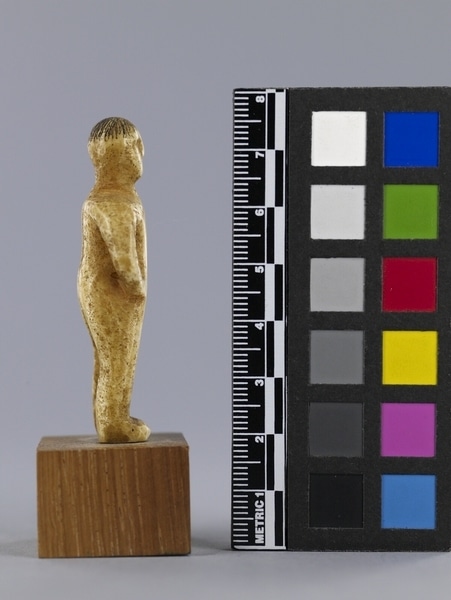Figure Item Number: Na1089 from the MOA: University of British Columbia




Description
Male or generic form with handless arms out from sides in oval shape. Oval face with nose in higher relief and incised hair-like lines on top of head. Legs with flat interior sides, curved in profile. Feet extend out to front. Vertical crease along back.
History Of Use
Traditional ivory dolls are carved by fathers as toys for their daughters. Skin and other clothing is usually removable and interchangeable. Small ivory figures are also used as fertility images by childless couples to help induce pregnancy. Figures may also stand in for individuals at important festivals. A wooden human image is a central figure at ceremonials related to hunting and fishing.
Cultural Context
Possibly Late Thule (Moos).
Item History
- Made in Nunavut, Canada before 1700
- Owned by Marianne Koerner and Walter C. Koerner before January 8, 1981
- Received from Marianne Koerner (Donor) and Walter C. Koerner (Donor) on January 8, 1981
What
- Name
- Figure
- Identification Number
- Na1089
- Type of Item
- figure
- Material
- walrus tusk
- Manufacturing Technique
- carved and incised
- Overall
- height 7.7 cm, width 2.5 cm, depth 2.5 cm
- Image
- height 5.6 cm, width 2.3 cm, depth 1.3 cm
Who
- Culture
- Inuit
- Previous Owner
- Marianne Koerner and Walter C. Koerner
- Received from
- Marianne Koerner (Donor) and Walter C. Koerner (Donor)
Where
- Holding Institution
- MOA: University of British Columbia
- Made in
- Nunavut, Canada
When
- Creation Date
- before 1700
- Ownership Date
- before January 8, 1981
- Acquisition Date
- on January 8, 1981
Other
- Item Classes
- carvings & sculpture
- Condition
- good
- Current Location
- Case 48
- Accession Number
- 0697/0010